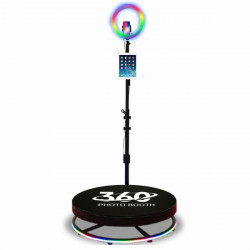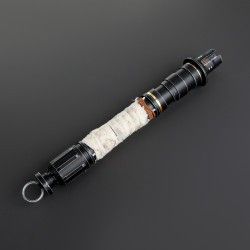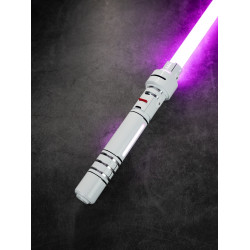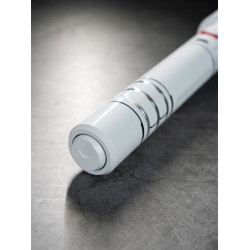
Why is Count Dooku’s Lightsaber Curved?
Count Dooku’s lightsaber is one of the most recognizable weapons in the Star Wars franchise.
Due to its curved hilt design, it differs from the conventional straight-hilt lightsabers used by the majority of Jedi and Sith.
This article will examine the factors that led to Count Dooku’s lightsaber’s distinctive design, tactical benefits, and position within Dooku’s more extensive weaponry.
The Design of Count Dooku’s Lightsaber
The bent hilt of Count Dooku’s lightsaber makes it readily identifiable.
This design improves Dooku’s duelling capabilities and has functional and aesthetically pleasing uses.
The Curved Hilt
The curving hilt of Count Dooku’s lightsaber is its main characteristic.
Instead of the conventional straight, the curved lightsaber hilt provides a more ergonomic grasp, which is especially useful in lightsaber battles.
Enhanced Precision and Control
The Count Dooku lightsaber’s curved hilt gives the user more control and accuracy.
For Dooku’s preferred classical fencing technique, this shape enables more precise attacks and finer movements.
Improved Angle of Attack
Complex moves and parries are made more accessible by the hilt’s curve, which alters the angle of attack.
This design element aids Dooku in keeping a competitive edge in one-on-one fights when skill and talent are crucial.
Continue reading: Which master-apprentice relationship is your favourite?
The Curved Lightsaber’s Origins and Inspiration
Ancient fencing customs and the character’s preferred fighting technique are the origins of Count Dooku’s lightsaber design.
Historical Fencing Influence
Historical fencing swords with curved handles, including daggers and sabres, significantly influenced Count Dooku’s lightsaber design. Dooku’s fighting style reflects the high ability and accuracy needed to use these weapons created for duelling.
Dooku’s Personal Fighting Style
Darth Tyranus, also known as Count Dooku, was a proficient duelist and a former Jedi Master. His fondness for Makashi, or Form II lightsaber battle, emphasized elegance, efficiency, and precision. His lightsaber’s curved hilt perfectly matches this approach, enabling him to take full advantage of Makashi’s advantages.
The Advantages of a Curved Lightsaber
The distinctive shape of Count Dooku’s lightsaber provides several tactical advantages, making it a potent weapon for a duelist of his calibre.
Increased Maneuverability
The lightsaber’s curved hilt improves mobility, enabling more fluid attacks and faster wrist movements. This facilitates the execution of the complex counters and methods typical of Makashi.
Better Grip and Control
The curved hilt’s ergonomic shape improves grip and lessens hand and wrist strain for the wielder during extended fighting.
This guarantees that Dooku will stay energized while fighting skillfully and accurately.
Psychological Edge
Count Dooku has a psychological advantage over his rivals due to the unique design of his lightsaber.
Dooku may have an edge because of his unique appearance, which can be intimidating and lead opponents to mistake or underestimate his fighting technique.
Symbolism in Dooku’s Weapon Design
In addition to being functional, Count Dooku’s lightsaber’s design is indicative of his personality and journey.
Elegance and Sophistication
The curving handle is a representation of Dooku’s grace and refinement.
Dooku holds himself in a refined manner as a former Jedi and a nobleman, and his lightsaber shows this quality.
Departure from Tradition
Dooku’s deviation from Jedi customs is further indicated by the distinctive design of his lightsaber.
Dooku highlights his departure from the Order and his adoption of the Sith worldview by selecting a weapon other than the traditional Jedi lightsaber.
Mastery and Skill
The curved hilt symbolizes Dooku’s expertise and proficiency in lightsaber battle.
It is a weapon that demands extreme skill and accuracy, underscoring Dooku’s reputation as one of the galaxy’s most formidable duelists.
The Impact of Count Dooku’s Lightsaber in Combat
Duel with Anakin Skywalker
A particularly noteworthy conflict utilizing Count Dooku’s lightsaber is his confrontation with Anakin Skywalker in “Star Wars: Episode III – Revenge of the Sith.”
This fight shows the effectiveness of Dooku’s bent lightsaber in deft hands, as he is able to withstand Anakin’s forceful blows.
Training Asajj Ventress
Asajj Ventress, Count Dooku’s pupil, is also taught how to wield a comparable curved lightsaber.
This demonstrates the design’s benefits and appropriateness for Makashi practitioners as Ventress develops into a strong duelist under Dooku’s guidance.
The Legacy of Count Dooku’s Lightsaber
Influence on Future Sith
Count Dooku’s distinctive lightsaber design has influenced other Sith and dark side users in Star Wars. Its unique look and combative efficacy have established a standard for cutting-edge weaponry.
Enduring Popularity
Even though he plays a villain, Star Wars fans still like Count Dooku and his curved lightsaber.
The weapon’s design always enthrals viewers, and it is commonly seen in video games, action figures, and replicas of the franchise.
Comparing Count Dooku’s Lightsaber to Other Lightsabers
Traditional Jedi Lightsabers
Straight hilts are a common feature of traditional Jedi lightsabers, which are made for general battle and versatility.
On the other hand, Count Dooku’s lightsaber is explicitly designed for duelling, demonstrating his preference for grace and accuracy above force.
Sith Lightsabers
Count Dooku’s lightsaber stresses control and elegance, unlike many Sith lightsabers made for aggression and force.
This distinguishes it from the lightsabers wielded by other Sith Lords, such as Darth Vader and Darth Maul, whose weapons are made for more violent fighting techniques.
Other Unique Lightsabers
There have been several distinctive designs in the history of Star Wars lightsabers, including Kylo Ren’s crossguard lightsaber and Darth Maul’s double-bladed lightsaber.
Count Dooku’s lightsaber continues the Star Wars universe’s heritage of invention by demonstrating a variety of designs.
The Future of Count Dooku’s Lightsaber
Potential Story Developments
As the Star Wars world grows, there might be more opportunities to explore the background and legacy of Count Dooku’s lightsaber.
Future narratives might explore how the weapon was developed and how it affected other Star Wars saga characters.
Fan Theories and Speculations
Fans are still discussing the meaning of Count Dooku’s lightsaber and its distinctive shape.
Several theories exist about it, ranging from its link to early Sith weaponry to its impact on upcoming lightsaber advancements.
Within the Star Wars community, these conversations maintain the weapon’s relevance and intrigue.
Legacy in Star Wars Merchandise
A typical piece of Star Wars memorabilia is Count Dooku’s lightsaber.
The weapon’s distinctive design enthrals fans and collectors, guaranteeing its place in Star Wars history through everything from fine replicas to intricate action figurines.
Conclusion
More than just a weapon, Count Dooku’s lightsaber symbolizes his personality, fighting style, and life experiences.
Its curved hilt design, inspired by ancient fencing swords, offers improved accuracy, control, and mobility.
Count Dooku’s lightsaber’s distinctive design and backstory underscore its importance in the Star Wars canon, leaving a lasting legacy that enthrals viewers and inspires new designs.
FAQs
How does Count Dooku’s lightsaber compare to other Jedi and Sith lightsabers in terms of functionality?
Unlike Jedi and Sith lightsabers, which frequently emphasize adaptability or raw power, Count Dooku’s lightsaber is made for accuracy and battle.
What materials are typically used to construct Count Dooku’s lightsaber?
Because Count Dooku’s lightsaber is made of premium metals and cutting-edge parts, it will last and perform well in battle.
How does the curved hilt of Count Dooku’s lightsaber affect his fighting style?
Dooku’s curved hilt improves control and accuracy, enabling him to carry out intricate movements and blows precisely.
Why did Count Dooku choose a curved lightsaber over a traditional straight hilt?
Dooku selected the curved form to complement his sophisticated and graceful duelling style, emphasizing skill and talent.
Is there any significance to the colour of Count Dooku’s lightsaber blade?
Although the blade’s red hue represents his loyalty to the Sith, the lightsaber’s construction and design emphasize his distinct fighting style and proficiency with lightsaber tactics.




















